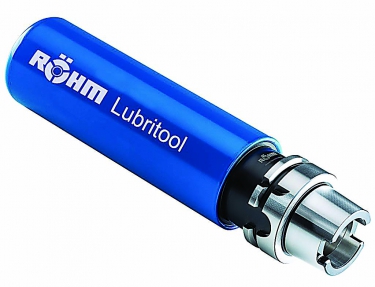Machine maintenance tasks are a pain. They take away from production time and can be labor-intensive and messy. Put them off too long, however, and the results are degraded processes and unplanned downtime at the worst possible times.
Tool-clamping systems on machining centers, for example, need to be serviced after about 75 hours of operation or 20,000 tool changes. That usually means shutting down the machine for several minutes to manually lubricate the clamps. The amount of lubrication that is needed depends on how long you’ve neglected maintenance.

Lubritool is designed for easy deployment from a machine’s tool magazine. Image courtesy of Röhm Products of America.
Bygones. The Röhm Lubritool enables automatic lubrication of tool-clamping sets. And, according to the manufacturer, it performs the job in seconds instead of minutes.
Like other tools, Lubritool is stored in the tool magazine when not in use. Whenever the machine control signals that lubrication is needed, Lubritool is placed into the spindle. It automatically deploys to the correct location and sprays just the desired amount of lubricant to the tool-clamping system.
After the lubrication process is completed, Lubritool is set back into the tool magazine to await the next cycle.
Lubritool includes a Lubriflux cartridge with enough lubricant for 100 routine scheduled lubrications. The device was introduced at EMO Hannover 2017.
For more information about Röhm Products of America Inc., Suwanee, Ga., visit www.rohm-products.com or call (770) 963-8440.
Contact Details
Related Glossary Terms
- centers
centers
Cone-shaped pins that support a workpiece by one or two ends during machining. The centers fit into holes drilled in the workpiece ends. Centers that turn with the workpiece are called “live” centers; those that do not are called “dead” centers.


